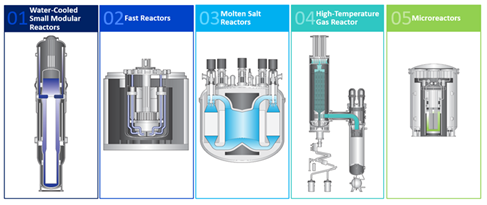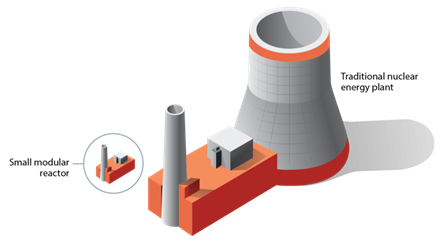Frequently Asked Questions
About Nebraska’s SMR Siting Study
What is the goal of the feasibility study?
A new technology called advanced small modular reactors (SMRs), also referred to as next generation nuclear, has the potential to revolutionize the energy industry, with the benefits of being more scalable than traditional commercial nuclear reactors. Under Legislative Bill 1014 (2022), Nebraska allocated $1 million of American Rescue Plan Act (ARPA) funding for a feasibility study to assess (1) siting options for new advanced nuclear reactors throughout Nebraska and (2) existing electric generation facilities based on key compatibility assets for such advanced nuclear reactors. The overarching goal of the study is to evaluate clean energy resources to improve water, sewer, and/or broadband infrastructure while reducing greenhouse gas (GHG) emissions across the state. This study will not result in the immediate construction of an SMR, but it will provide an in-depth overview of potential areas in the state where this technology could be suitably sited.
Who is conducting the study?
The Nebraska Legislature authorized the Nebraska Department of Economic Development (DED) to distribute funding for the feasibility study. DED awarded the funds to Nebraska Public Power District (NPPD) which operates Cooper Nuclear Station near Brownville—the state’s only nuclear power generator. NPPD retained a consulting firm, 1898 & Co., to investigate potential locations for an SMR facility to provide clean energy to the state of Nebraska.
How many phases are there for the siting study?
The purpose of the study’s first phase was to review published data to help screen areas with geographic and infrastructure characteristics that would make them potential candidates for an emerging nuclear technology known as a Small Modular Reactor (SMR). SMRs offer unique attributes in terms of flexibility, efficiency, and safety. Phase 1 of the study considered areas across the entire state, including current generation sites.
The study’s second phase will perform a more in-depth technical evaluation and will involve detailed field environmental and constructability evaluations based on criteria used by the Nuclear Regulatory Commission (NRC). Phase 2 will also include engagement with the communities listed as potentially feasible sites. At the conclusion of Phase 2, the list will be shortened to two to four sites. Local support will be an important factor for a community to move past the second phase.
How will the findings from the two-phase feasibility study be shared?
DED and/or NPPD will share results with candidate communities through press releases and other communications. Updates regarding this project are also hosted on nextgennuclearne.com.
Does this mean Nebraska is getting a next generation nuclear facility?
This study will not result in the immediate construction of a next generation nuclear facility; however it will provide an initial investigation into areas in the state where this technology could be most beneficially sited. Since the initial phase of this study is focused solely on high-level siting criteria, a particular type of SMR has not yet been identified for future potential construction.
What does this mean for Nebraska’s future energy supply?
This study will provide a baseline of potential sites where a clean energy generation source could be sited in the future. Such a carbon-free, dispatchable generation facility would further complement the resiliency and flexibility of our overall electric grid, enhancing reliability.
Why are we exploring next generation nuclear now?
Although affordable commercial installations of next generation nuclear are likely years away, completing this upfront work could provide pre-planning (up to and including a site licensed by the NRC) to prepare for the successful future commercial operation of an SMR in Nebraska. Though there are no next generation nuclear facilities currently in commercial operation, there are more than a dozen demonstration projects in progress in North America scheduled to come on-line around the end of the decade.
How long will it take to complete the feasibility study?
Phase 2 will be completed by the end of 2026. After the grant ends, if an identified potential community is interested in being a location for a possible next generation nuclear facility, the process could be extended.
What are the study’s basic requirements?
Technical guidance from the Nuclear Regulatory Commission (NRC) and the Electric Power Research Institute was used to assess potential sites for relative ease of construction and operations.
Could a next generation nuclear facility be located anywhere in Nebraska?
Preliminary sites were selected that minimized barriers to constructing and operating a potential new facility. The best sites are those that maximize existing energy infrastructure and workforce availability.
SMR Community Benefits
How could next generation nuclear energy benefit my community?
Advanced nuclear energy offers various benefits to communities, including energy security, economic growth, high-paying jobs, and a dependable, affordable and carbon-free energy system.
General
What is an SMR?
Advanced small modular reactors are a next generation nuclear solution. SMRs are units that potentially have lower initial capital investment, greater scalability, siting flexibility due to their smaller footprint, passive safety systems, and a variety of operational features (such as load following, heat storage, steam for process heat), resulting in highly flexible operations. SMRs can be beneficial for driving economic growth within a community.
SMR modules range from five megawatts (MW) to 300 MW, with most major components fabricated in a factory environment for more efficient and secure construction. Multiple units can be co-located on the same site to match load. SMRs can ramp energy output up or down rapidly. This is a very important feature in ensuring a diverse generation mix that can effectively respond to the variability of load and renewable generation output.
Below is a visual of some general types of SMRs. Different designs and operational characteristics fit different needs.

What type of footprint does next generation nuclear have?
In relation to most other forms of clean energy, nuclear has a comparatively small footprint. And SMRs have an even smaller footprint than the large, traditional reactor sites in existence around the world. Many of the benefits of SMRs are inherently linked to the nature of their design – small and modular. SMRs can produce a lot of electricity in a relatively small footprint. Given their smaller footprint, SMRs can be sited on locations not suitable for larger nuclear power plants. For example, one of the proposed 920 MW NuScale SMR would have a 35-acre footprint, while a traditional nuclear plant generating the same amount of electricity would require nearly 500 acres.
In general, the geographical footprint of nuclear power plants is very small even compared with other generation sources such as hydropower, solar, or wind facilities. Current advanced nuclear power plants are also capable of generating more electricity with less land than all other renewable energy sources. For example, to generate the same amount of electricity as a 1,000 MW SMR, a wind farm would require more than 140,000 acres, which is more than 170 times the land needed for a nuclear reactor.
The smaller footprint, along with reduced water needs, allows for flexibility of locating SMRs in areas where large plants are not needed or in areas that lack the infrastructure to support a large unit.

Graphic courtesy Idaho National Laboratory website: Advanced Small Modular Reactors – Idaho National Laboratory (inl.gov)
Is there public and governmental support for new nuclear reactors?
A 2023 Gallup poll shows Americans’ support for nuclear energy is the highest it has been in a decade. Sixty-one percent of respondents said the U.S. should be spending more on nuclear energy research and development. Many residents welcome new nuclear reactors because of their communities’ benefits. For example, in Wyoming, four communities competed to host the first reactor in the state, which is being built by TerraPower and PacifiCorp in partnership with the Department of Energy.
At national and state levels, governments are positioning themselves to be nuclear-friendly as they see the potential of this safe and green energy source.
Are SMRs safe?
Safety is in the DNA of every U.S. nuclear energy plant. That’s one of the benefits of nuclear energy: U.S. plants are among the safest and most secure industrial facilities in the country. The safety of employees and the communities is top priority. Nuclear power plants maintain the highest standard for operational safety, security, cybersecurity and emergency preparedness. The industry’s comprehensive safety procedures and stringent federal regulations keep our plants and neighboring communities safe.
Advanced reactors incorporate a multitude of safety features, building upon experience from the unparalleled safety operations of the current fleet of nuclear plants during the last 60+ years. Next generation nuclear plants are protected by multiple backup safety systems that are capable of operating without backup electricity. This means they don’t require active systems like pumps or valves, but actually rely on things like gravity and natural convection to ensure that the reactors, the workers, and the public stay safe.
Is next generation nuclear affordable?
In terms of construction, next generation nuclear strives to be in similar cost ranges to other new generation options. Regulatory requirements drive most of the cost differential when compared with other new generation sources.
How does next generation nuclear complement current/future generation options?
Nuclear energy is the only clean energy source capable of continuous operation, 24/7/365. In contrast, wind and solar generation are intermittent and are not constantly available. This highlights the importance of both traditional and advanced nuclear power plants, as they can complement renewable electricity generation.
Further, nuclear power is the only clean energy source that can support decarbonization at the scale needed to meet global emission reduction targets. SMRs not only generate massive quantities of clean electricity well beyond any other source, but they can also decarbonize other industries by producing the hydrogen and process heat needed for transportation and manufacturing, which currently produce a significant amount of global greenhouse gas emissions.
Do small modular reactors produce used fuel?
Advanced nuclear reactors may produce smaller amounts of used fuel, in forms that will make disposal easier. Some designs will even allow power companies to recover and recycle elements in used nuclear fuel that can still produce energy.
How will advanced nuclear reactors incorporate even more safety features?
This will occur in two key ways: The first is through the incorporation of advanced fuel types that take advantage of the 60 years of operating experience we have with today’s reactors. The second way is through the incorporation of safety features that don’t require active systems like pumps or values but actually rely on things like gravity and natural convection to ensure the reactors, workers, and the public stay safe.
I’m thankful the facility is there. Nuclear adds so much by bringing the jobs, bringing the people, and everything that comes from that. It’s a huge benefit for our community.
